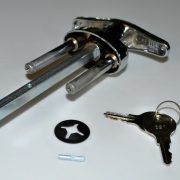
The original door also “featured” the opposite of insulation. The old garage door was not helping curb appeal.

The door was powered by an opener that was so old I had push the button and then sprint to the door to physically help lift it open before it would stall out (to be replaced by a LiftMaster opener, more on that in an upcoming separate review). While some things from the 60’s or 70’s are now considered “vintage” or “shabby chic”, our door was going more for just “shabby.” It sported what was likely the original coat of dull brown paint that had faded so much that it was more of a chalky dark beige. Although we were not able to carbon date the door, estimates put its origins around the 1960’s or 70’s. To get a true impression of how far a new garage door went in our case, we need to begin with the state of our garage in the b.c. Read on, and we’ll walk you through just about everything you might consider when shopping for a new garage door, and we might even entice you into action with some inspiring before and after shots! The Garage Door Before This was the sorry state of affairs in the official “before” shot. They agreed to sponsor this review and makeover project with one of their Canyon Ridge garage doors. We talked to our friends over at Clopay garage doors about what we saw as a stellar before/after opportunity. I spent a good deal of time and effort working on details of the home to enhance its visual appeal, but the garage door was one glaring eyesore that needed to be corrected.

In the case of our 1930’s Spanish style home, the garage door was most definitely working against it. That can either work for your home’s curb appeal, or it can work against it. According to Clopay, garage doors represent up to 40 percent of a home’s façade. There are few things that dominate the facade of homes more than their garage doors.


 0 kommentar(er)
0 kommentar(er)
